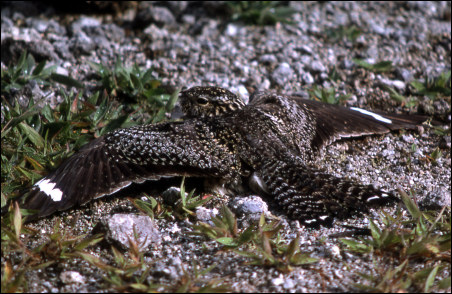
|
Context Kingdom: Animalia |
 |
Common Nighthawk (Chordeiles minor). Photograph by J. Hemphill, courtesy of Yellowstone National Park, National Park Service. |
Common Nighthawks have a relatively medium-sized build. They run from 22 to 24 cm in length and weigh 65 to 98 g (Kropp, 2002). They have large mouths and eyes. the head is flattened. There is a notch on the end of the tail and the long, slender, pointed wings have white patches on the primary feathers which are visible in flight. (DigiMorph Staff, 2004).
Chordeiles minor habitats include a wide variety of open countryside as well as open forests (Kropp, 2002). Human-altered habitats, such as logged or burned forests, cultivated fields, and cities, also may be utilized (Kropp, 2002). Common Nighthawks are ground nesters, with the nests, a shallow depression in the ground, located in open areas having some cover supplied by such things as shrubs, grasses, or boulders. (Kropp, 2002). A variety of substrates may be used for nesting, including sand, gravel, leaves, and bare rock. Relatively little is known about the details of migration and winter habitat (Kropp, 2002).
Chordeiles minor breeds throughout most of North America and south into parts of Central America. Their winter distribution isn't as clearly defined, but the lowland areas of the middle portions of South America are believed to be inhabited (Kropp, 2002). Migration routes covering some 4,000 to 11,000 km (2,500 to 6,800 miles) give them one of the longest migrations of any bird of the Americas (Kropp, 2002).
The diet consists mainly of insects, with the majority of the diet made up of ants, beetles, and true bugs. The birds are crepuscular, being active primarily in twilight hours before dawn and just after sunset. They feed on the wing (Kropp, 2002). Their unpredictable flight patterns result from feeding on a variety of prey types active at those times. Common Nighthawks drink in flight by skimming the surface of bodies of water with their bills (Kropp, 2002).
Courtship displays by males begin in the air and are completed on the ground. The initial display is of the male flying some 5 to 30 m high and then diving steeply toward the ground; pulling up abruptly about 2 m above the ground produces a "booming" noise from air forced through the primary feathers. The aerial display is following by landing near the female, displaying the white throat patch while the tail is spread and shaken and a croaking noise is made.(Kropp, 2002)
DigiMorph Staff. 2004. Chordeiles minor (On-line). Digital Morphology. Accessed 28 February 2006 at http://digimorph.org/specimens/Chordeiles_minor/head.
Kropp, R. 2002. "Chordeiles minor" (On-line) Animal Diversity Web. Accessed 28 February 2006 at http://animaldiversity.ummz.umich.edu/site/accounts/information/Chordeiles_minor.html
Michelle Brennan, February, 2006.
